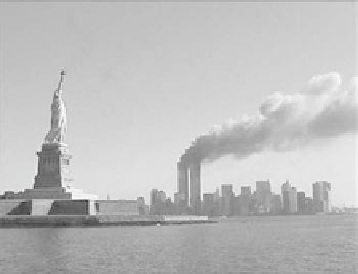Geoscience Reference
In-Depth Information
Figure 7.1 World Trade Center towers in New York City following terrorist
attacks on September 11, 2001. (Photo courtesy of the National Park Service.)
Hurricane Katrina, August 2005
Lessons Learned
The Department of Homeland Security, in coordination with state and local gov-
ernments and the private sector, should develop a modern, flexible, and transparent
logistics system. This system should be based on established contracts for stockpil-
ing commodities at the local level for emergencies and the provision of goods and
services during emergencies. The federal government must develop the capacity to
conduct large-scale logistical operations that supplement and, if necessary, replace
state and local logistical systems by leveraging resources within both the public
sector and the private sector.
2
The federal response should better integrate the contributions of volunteers and
nongovernmental organizations (NGOs) into the broader national effort. This inte-
gration would be best achieved at the state and local levels, before incidents occur.
In particular, state and local governments must engage NGOs in the planning
process, credential their personnel, and provide them with the necessary resource
support for their involvement in a joint response.
3
The Department of Homeland Security should develop a comprehensive pro-
gram for the professional development and education of the nation's homeland
security personnel, including federal, state and local employees as well as emer-
gency management persons within the private sector, NGOs, as well as faith-based
and community groups. This program should foster a “joint” federal interagency,
state, local, and civilian team (Figure 7.2).
3
Creating a Culture of Preparedness—Initiative
We must build on our initial successful efforts to partner with other homeland
security stakeholders—private sector, NGOs, and faith-based groups. Each of these

